Service Management Report: Analysis of British Airways and EasyJet
VerifiedAdded on 2020/01/07
|13
|4148
|92
Report
AI Summary
This report provides a comprehensive analysis of service management practices within two major airline companies: British Airways and EasyJet. The report delves into various aspects of their operations, including their service concepts, service design strategies, and how they align with customer needs. It examines the understanding of the service concepts among both customers and staff, and assesses the rate of success of their adopted service strategies. Furthermore, the report explores quality management techniques, quality control mechanisms, and capacity and facilities management within both airlines. It also investigates their approaches to complaint management, branding, promotion, and HR strategies. Through primary and secondary research, the report offers insights into the strengths and weaknesses of each airline's service management, providing a comparative analysis and concluding with recommendations for improvement. The report highlights key differences in their service offerings, such as British Airways' focus on premium services versus EasyJet's emphasis on affordable fares and operational efficiency.
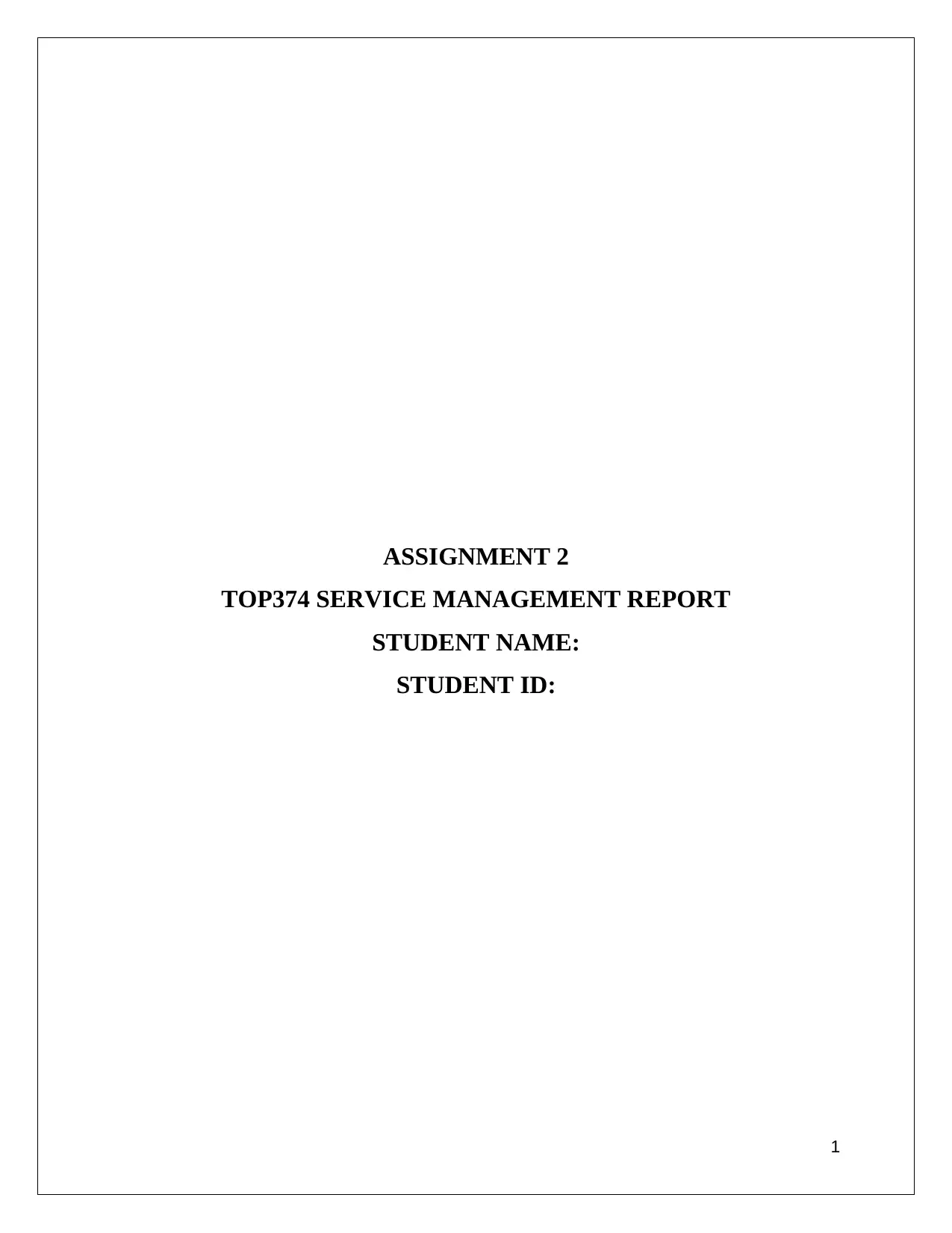
ASSIGNMENT 2
TOP374 SERVICE MANAGEMENT REPORT
STUDENT NAME:
STUDENT ID:
1
TOP374 SERVICE MANAGEMENT REPORT
STUDENT NAME:
STUDENT ID:
1
Paraphrase This Document
Need a fresh take? Get an instant paraphrase of this document with our AI Paraphraser
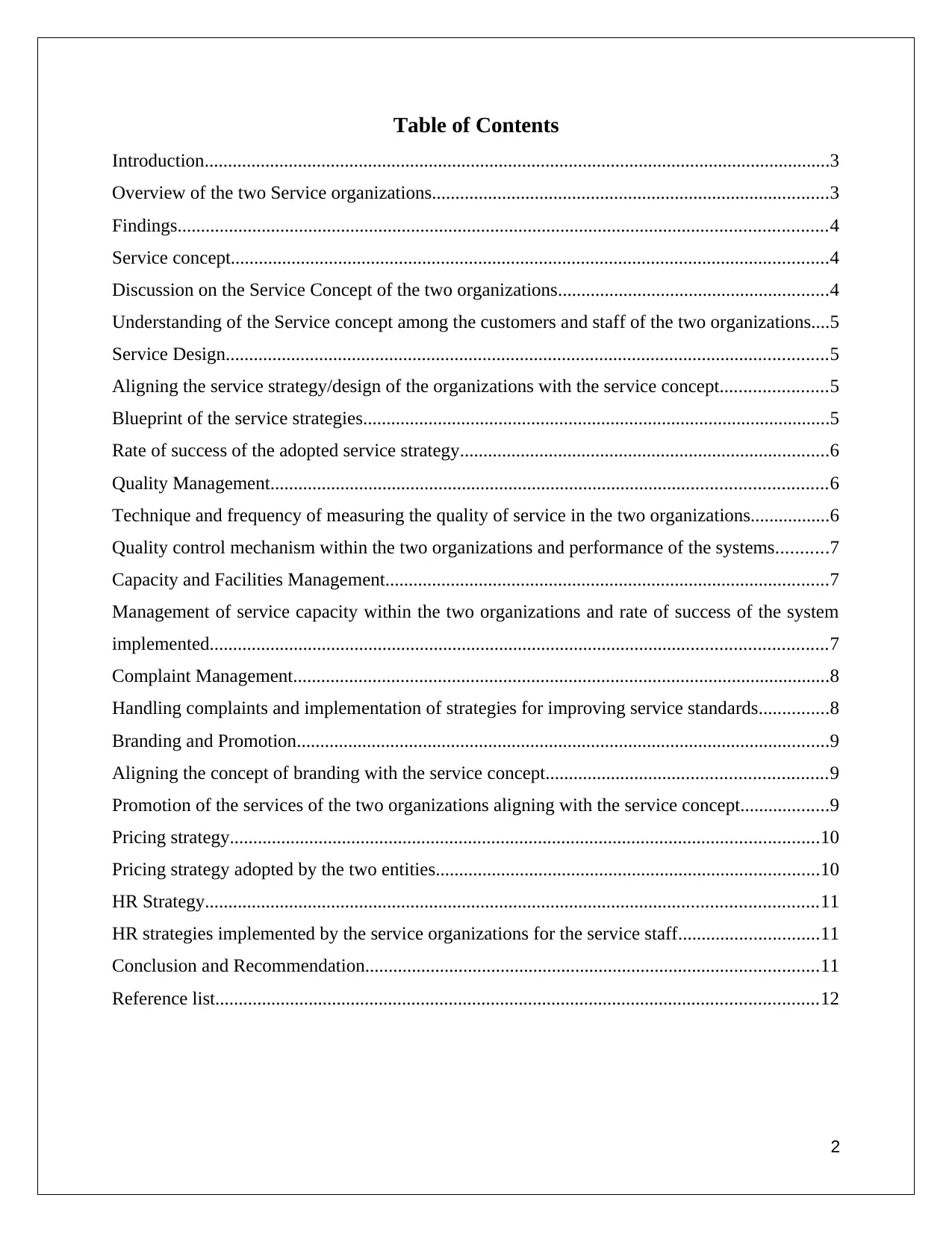
Table of Contents
Introduction......................................................................................................................................3
Overview of the two Service organizations.....................................................................................3
Findings...........................................................................................................................................4
Service concept................................................................................................................................4
Discussion on the Service Concept of the two organizations..........................................................4
Understanding of the Service concept among the customers and staff of the two organizations....5
Service Design.................................................................................................................................5
Aligning the service strategy/design of the organizations with the service concept.......................5
Blueprint of the service strategies....................................................................................................5
Rate of success of the adopted service strategy...............................................................................6
Quality Management.......................................................................................................................6
Technique and frequency of measuring the quality of service in the two organizations.................6
Quality control mechanism within the two organizations and performance of the systems...........7
Capacity and Facilities Management...............................................................................................7
Management of service capacity within the two organizations and rate of success of the system
implemented....................................................................................................................................7
Complaint Management...................................................................................................................8
Handling complaints and implementation of strategies for improving service standards...............8
Branding and Promotion..................................................................................................................9
Aligning the concept of branding with the service concept............................................................9
Promotion of the services of the two organizations aligning with the service concept...................9
Pricing strategy..............................................................................................................................10
Pricing strategy adopted by the two entities..................................................................................10
HR Strategy...................................................................................................................................11
HR strategies implemented by the service organizations for the service staff..............................11
Conclusion and Recommendation.................................................................................................11
Reference list.................................................................................................................................12
2
Introduction......................................................................................................................................3
Overview of the two Service organizations.....................................................................................3
Findings...........................................................................................................................................4
Service concept................................................................................................................................4
Discussion on the Service Concept of the two organizations..........................................................4
Understanding of the Service concept among the customers and staff of the two organizations....5
Service Design.................................................................................................................................5
Aligning the service strategy/design of the organizations with the service concept.......................5
Blueprint of the service strategies....................................................................................................5
Rate of success of the adopted service strategy...............................................................................6
Quality Management.......................................................................................................................6
Technique and frequency of measuring the quality of service in the two organizations.................6
Quality control mechanism within the two organizations and performance of the systems...........7
Capacity and Facilities Management...............................................................................................7
Management of service capacity within the two organizations and rate of success of the system
implemented....................................................................................................................................7
Complaint Management...................................................................................................................8
Handling complaints and implementation of strategies for improving service standards...............8
Branding and Promotion..................................................................................................................9
Aligning the concept of branding with the service concept............................................................9
Promotion of the services of the two organizations aligning with the service concept...................9
Pricing strategy..............................................................................................................................10
Pricing strategy adopted by the two entities..................................................................................10
HR Strategy...................................................................................................................................11
HR strategies implemented by the service organizations for the service staff..............................11
Conclusion and Recommendation.................................................................................................11
Reference list.................................................................................................................................12
2
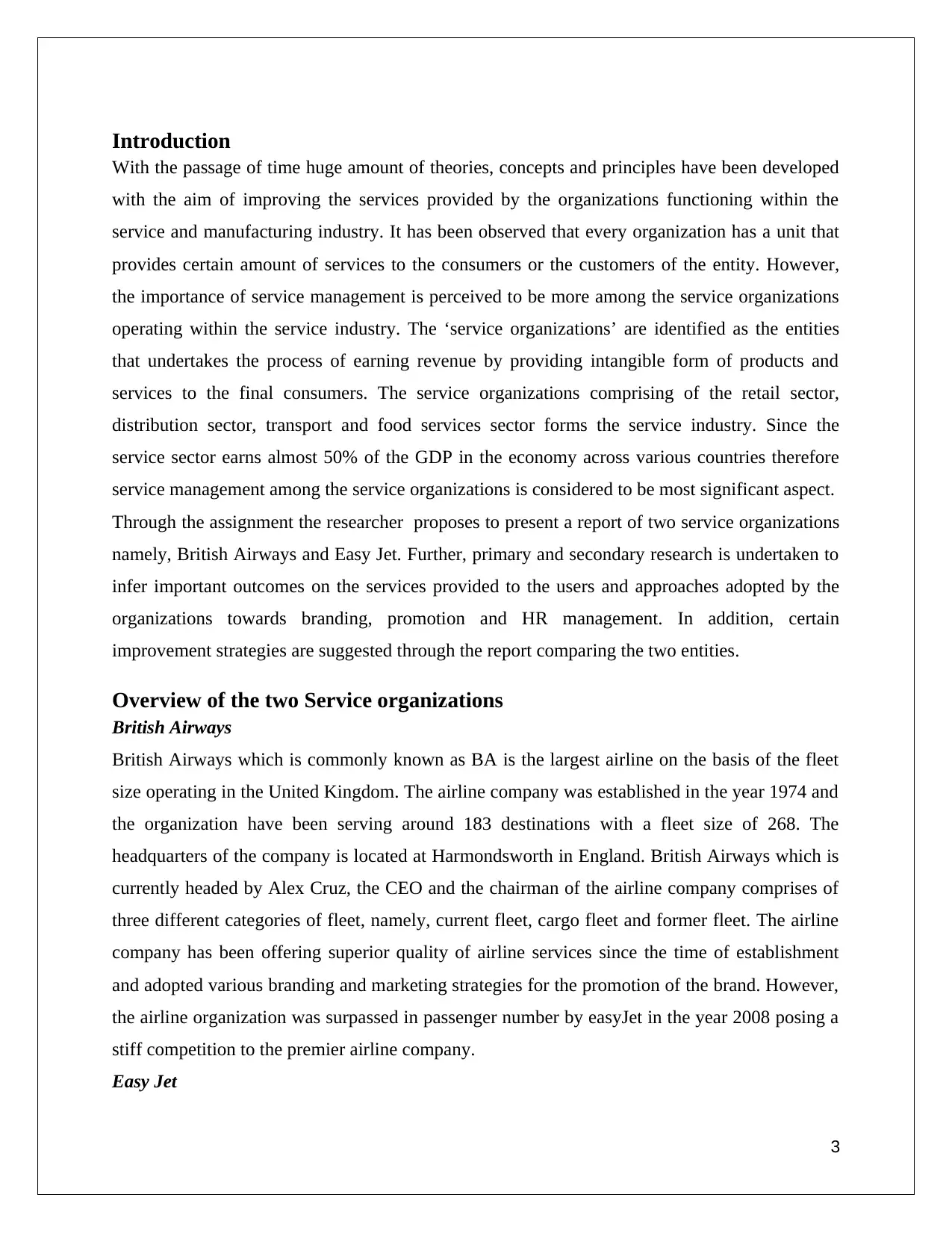
Introduction
With the passage of time huge amount of theories, concepts and principles have been developed
with the aim of improving the services provided by the organizations functioning within the
service and manufacturing industry. It has been observed that every organization has a unit that
provides certain amount of services to the consumers or the customers of the entity. However,
the importance of service management is perceived to be more among the service organizations
operating within the service industry. The ‘service organizations’ are identified as the entities
that undertakes the process of earning revenue by providing intangible form of products and
services to the final consumers. The service organizations comprising of the retail sector,
distribution sector, transport and food services sector forms the service industry. Since the
service sector earns almost 50% of the GDP in the economy across various countries therefore
service management among the service organizations is considered to be most significant aspect.
Through the assignment the researcher proposes to present a report of two service organizations
namely, British Airways and Easy Jet. Further, primary and secondary research is undertaken to
infer important outcomes on the services provided to the users and approaches adopted by the
organizations towards branding, promotion and HR management. In addition, certain
improvement strategies are suggested through the report comparing the two entities.
Overview of the two Service organizations
British Airways
British Airways which is commonly known as BA is the largest airline on the basis of the fleet
size operating in the United Kingdom. The airline company was established in the year 1974 and
the organization have been serving around 183 destinations with a fleet size of 268. The
headquarters of the company is located at Harmondsworth in England. British Airways which is
currently headed by Alex Cruz, the CEO and the chairman of the airline company comprises of
three different categories of fleet, namely, current fleet, cargo fleet and former fleet. The airline
company has been offering superior quality of airline services since the time of establishment
and adopted various branding and marketing strategies for the promotion of the brand. However,
the airline organization was surpassed in passenger number by easyJet in the year 2008 posing a
stiff competition to the premier airline company.
Easy Jet
3
With the passage of time huge amount of theories, concepts and principles have been developed
with the aim of improving the services provided by the organizations functioning within the
service and manufacturing industry. It has been observed that every organization has a unit that
provides certain amount of services to the consumers or the customers of the entity. However,
the importance of service management is perceived to be more among the service organizations
operating within the service industry. The ‘service organizations’ are identified as the entities
that undertakes the process of earning revenue by providing intangible form of products and
services to the final consumers. The service organizations comprising of the retail sector,
distribution sector, transport and food services sector forms the service industry. Since the
service sector earns almost 50% of the GDP in the economy across various countries therefore
service management among the service organizations is considered to be most significant aspect.
Through the assignment the researcher proposes to present a report of two service organizations
namely, British Airways and Easy Jet. Further, primary and secondary research is undertaken to
infer important outcomes on the services provided to the users and approaches adopted by the
organizations towards branding, promotion and HR management. In addition, certain
improvement strategies are suggested through the report comparing the two entities.
Overview of the two Service organizations
British Airways
British Airways which is commonly known as BA is the largest airline on the basis of the fleet
size operating in the United Kingdom. The airline company was established in the year 1974 and
the organization have been serving around 183 destinations with a fleet size of 268. The
headquarters of the company is located at Harmondsworth in England. British Airways which is
currently headed by Alex Cruz, the CEO and the chairman of the airline company comprises of
three different categories of fleet, namely, current fleet, cargo fleet and former fleet. The airline
company has been offering superior quality of airline services since the time of establishment
and adopted various branding and marketing strategies for the promotion of the brand. However,
the airline organization was surpassed in passenger number by easyJet in the year 2008 posing a
stiff competition to the premier airline company.
Easy Jet
3
⊘ This is a preview!⊘
Do you want full access?
Subscribe today to unlock all pages.

Trusted by 1+ million students worldwide
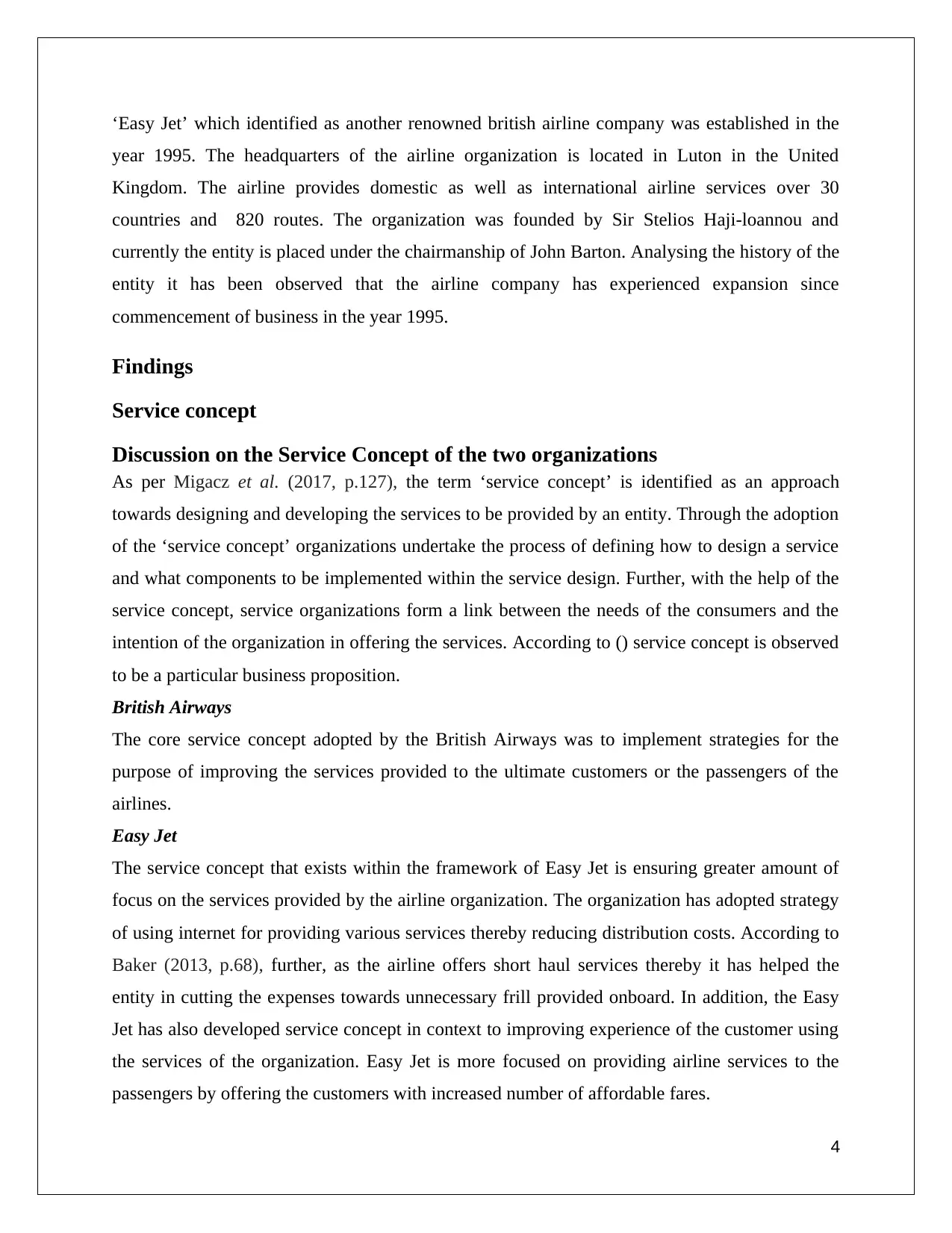
‘Easy Jet’ which identified as another renowned british airline company was established in the
year 1995. The headquarters of the airline organization is located in Luton in the United
Kingdom. The airline provides domestic as well as international airline services over 30
countries and 820 routes. The organization was founded by Sir Stelios Haji-loannou and
currently the entity is placed under the chairmanship of John Barton. Analysing the history of the
entity it has been observed that the airline company has experienced expansion since
commencement of business in the year 1995.
Findings
Service concept
Discussion on the Service Concept of the two organizations
As per Migacz et al. (2017, p.127), the term ‘service concept’ is identified as an approach
towards designing and developing the services to be provided by an entity. Through the adoption
of the ‘service concept’ organizations undertake the process of defining how to design a service
and what components to be implemented within the service design. Further, with the help of the
service concept, service organizations form a link between the needs of the consumers and the
intention of the organization in offering the services. According to () service concept is observed
to be a particular business proposition.
British Airways
The core service concept adopted by the British Airways was to implement strategies for the
purpose of improving the services provided to the ultimate customers or the passengers of the
airlines.
Easy Jet
The service concept that exists within the framework of Easy Jet is ensuring greater amount of
focus on the services provided by the airline organization. The organization has adopted strategy
of using internet for providing various services thereby reducing distribution costs. According to
Baker (2013, p.68), further, as the airline offers short haul services thereby it has helped the
entity in cutting the expenses towards unnecessary frill provided onboard. In addition, the Easy
Jet has also developed service concept in context to improving experience of the customer using
the services of the organization. Easy Jet is more focused on providing airline services to the
passengers by offering the customers with increased number of affordable fares.
4
year 1995. The headquarters of the airline organization is located in Luton in the United
Kingdom. The airline provides domestic as well as international airline services over 30
countries and 820 routes. The organization was founded by Sir Stelios Haji-loannou and
currently the entity is placed under the chairmanship of John Barton. Analysing the history of the
entity it has been observed that the airline company has experienced expansion since
commencement of business in the year 1995.
Findings
Service concept
Discussion on the Service Concept of the two organizations
As per Migacz et al. (2017, p.127), the term ‘service concept’ is identified as an approach
towards designing and developing the services to be provided by an entity. Through the adoption
of the ‘service concept’ organizations undertake the process of defining how to design a service
and what components to be implemented within the service design. Further, with the help of the
service concept, service organizations form a link between the needs of the consumers and the
intention of the organization in offering the services. According to () service concept is observed
to be a particular business proposition.
British Airways
The core service concept adopted by the British Airways was to implement strategies for the
purpose of improving the services provided to the ultimate customers or the passengers of the
airlines.
Easy Jet
The service concept that exists within the framework of Easy Jet is ensuring greater amount of
focus on the services provided by the airline organization. The organization has adopted strategy
of using internet for providing various services thereby reducing distribution costs. According to
Baker (2013, p.68), further, as the airline offers short haul services thereby it has helped the
entity in cutting the expenses towards unnecessary frill provided onboard. In addition, the Easy
Jet has also developed service concept in context to improving experience of the customer using
the services of the organization. Easy Jet is more focused on providing airline services to the
passengers by offering the customers with increased number of affordable fares.
4
Paraphrase This Document
Need a fresh take? Get an instant paraphrase of this document with our AI Paraphraser
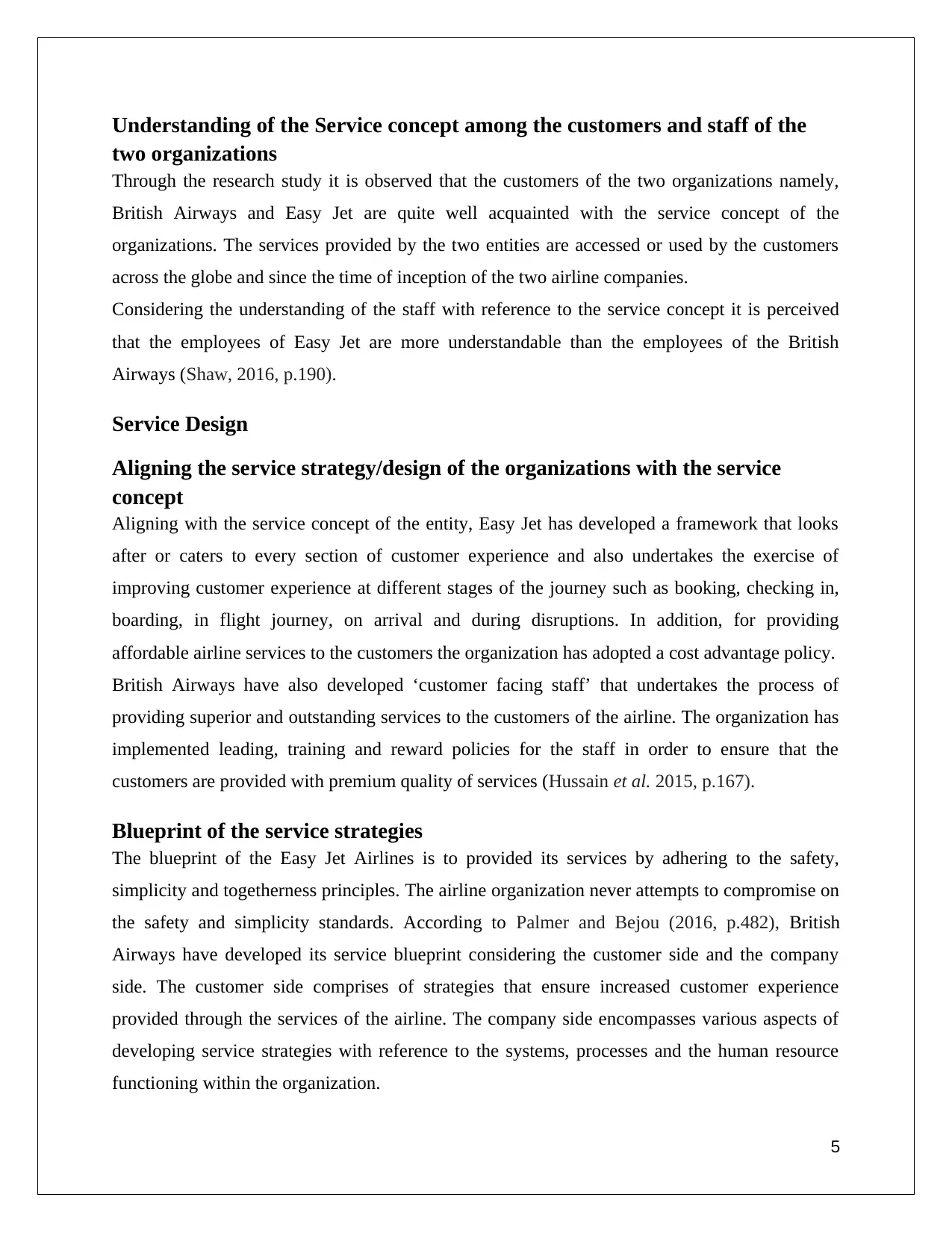
Understanding of the Service concept among the customers and staff of the
two organizations
Through the research study it is observed that the customers of the two organizations namely,
British Airways and Easy Jet are quite well acquainted with the service concept of the
organizations. The services provided by the two entities are accessed or used by the customers
across the globe and since the time of inception of the two airline companies.
Considering the understanding of the staff with reference to the service concept it is perceived
that the employees of Easy Jet are more understandable than the employees of the British
Airways (Shaw, 2016, p.190).
Service Design
Aligning the service strategy/design of the organizations with the service
concept
Aligning with the service concept of the entity, Easy Jet has developed a framework that looks
after or caters to every section of customer experience and also undertakes the exercise of
improving customer experience at different stages of the journey such as booking, checking in,
boarding, in flight journey, on arrival and during disruptions. In addition, for providing
affordable airline services to the customers the organization has adopted a cost advantage policy.
British Airways have also developed ‘customer facing staff’ that undertakes the process of
providing superior and outstanding services to the customers of the airline. The organization has
implemented leading, training and reward policies for the staff in order to ensure that the
customers are provided with premium quality of services (Hussain et al. 2015, p.167).
Blueprint of the service strategies
The blueprint of the Easy Jet Airlines is to provided its services by adhering to the safety,
simplicity and togetherness principles. The airline organization never attempts to compromise on
the safety and simplicity standards. According to Palmer and Bejou (2016, p.482), British
Airways have developed its service blueprint considering the customer side and the company
side. The customer side comprises of strategies that ensure increased customer experience
provided through the services of the airline. The company side encompasses various aspects of
developing service strategies with reference to the systems, processes and the human resource
functioning within the organization.
5
two organizations
Through the research study it is observed that the customers of the two organizations namely,
British Airways and Easy Jet are quite well acquainted with the service concept of the
organizations. The services provided by the two entities are accessed or used by the customers
across the globe and since the time of inception of the two airline companies.
Considering the understanding of the staff with reference to the service concept it is perceived
that the employees of Easy Jet are more understandable than the employees of the British
Airways (Shaw, 2016, p.190).
Service Design
Aligning the service strategy/design of the organizations with the service
concept
Aligning with the service concept of the entity, Easy Jet has developed a framework that looks
after or caters to every section of customer experience and also undertakes the exercise of
improving customer experience at different stages of the journey such as booking, checking in,
boarding, in flight journey, on arrival and during disruptions. In addition, for providing
affordable airline services to the customers the organization has adopted a cost advantage policy.
British Airways have also developed ‘customer facing staff’ that undertakes the process of
providing superior and outstanding services to the customers of the airline. The organization has
implemented leading, training and reward policies for the staff in order to ensure that the
customers are provided with premium quality of services (Hussain et al. 2015, p.167).
Blueprint of the service strategies
The blueprint of the Easy Jet Airlines is to provided its services by adhering to the safety,
simplicity and togetherness principles. The airline organization never attempts to compromise on
the safety and simplicity standards. According to Palmer and Bejou (2016, p.482), British
Airways have developed its service blueprint considering the customer side and the company
side. The customer side comprises of strategies that ensure increased customer experience
provided through the services of the airline. The company side encompasses various aspects of
developing service strategies with reference to the systems, processes and the human resource
functioning within the organization.
5
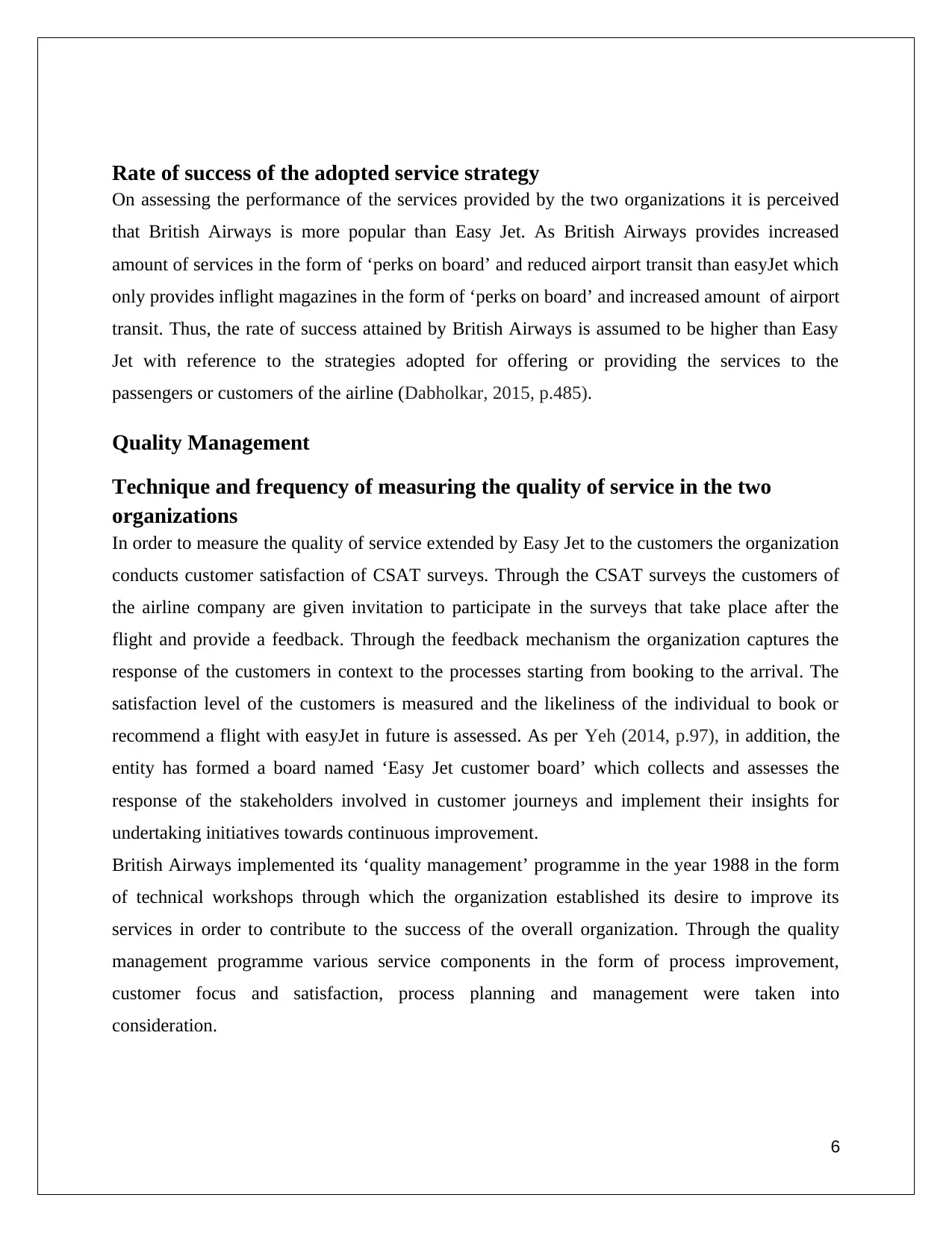
Rate of success of the adopted service strategy
On assessing the performance of the services provided by the two organizations it is perceived
that British Airways is more popular than Easy Jet. As British Airways provides increased
amount of services in the form of ‘perks on board’ and reduced airport transit than easyJet which
only provides inflight magazines in the form of ‘perks on board’ and increased amount of airport
transit. Thus, the rate of success attained by British Airways is assumed to be higher than Easy
Jet with reference to the strategies adopted for offering or providing the services to the
passengers or customers of the airline (Dabholkar, 2015, p.485).
Quality Management
Technique and frequency of measuring the quality of service in the two
organizations
In order to measure the quality of service extended by Easy Jet to the customers the organization
conducts customer satisfaction of CSAT surveys. Through the CSAT surveys the customers of
the airline company are given invitation to participate in the surveys that take place after the
flight and provide a feedback. Through the feedback mechanism the organization captures the
response of the customers in context to the processes starting from booking to the arrival. The
satisfaction level of the customers is measured and the likeliness of the individual to book or
recommend a flight with easyJet in future is assessed. As per Yeh (2014, p.97), in addition, the
entity has formed a board named ‘Easy Jet customer board’ which collects and assesses the
response of the stakeholders involved in customer journeys and implement their insights for
undertaking initiatives towards continuous improvement.
British Airways implemented its ‘quality management’ programme in the year 1988 in the form
of technical workshops through which the organization established its desire to improve its
services in order to contribute to the success of the overall organization. Through the quality
management programme various service components in the form of process improvement,
customer focus and satisfaction, process planning and management were taken into
consideration.
6
On assessing the performance of the services provided by the two organizations it is perceived
that British Airways is more popular than Easy Jet. As British Airways provides increased
amount of services in the form of ‘perks on board’ and reduced airport transit than easyJet which
only provides inflight magazines in the form of ‘perks on board’ and increased amount of airport
transit. Thus, the rate of success attained by British Airways is assumed to be higher than Easy
Jet with reference to the strategies adopted for offering or providing the services to the
passengers or customers of the airline (Dabholkar, 2015, p.485).
Quality Management
Technique and frequency of measuring the quality of service in the two
organizations
In order to measure the quality of service extended by Easy Jet to the customers the organization
conducts customer satisfaction of CSAT surveys. Through the CSAT surveys the customers of
the airline company are given invitation to participate in the surveys that take place after the
flight and provide a feedback. Through the feedback mechanism the organization captures the
response of the customers in context to the processes starting from booking to the arrival. The
satisfaction level of the customers is measured and the likeliness of the individual to book or
recommend a flight with easyJet in future is assessed. As per Yeh (2014, p.97), in addition, the
entity has formed a board named ‘Easy Jet customer board’ which collects and assesses the
response of the stakeholders involved in customer journeys and implement their insights for
undertaking initiatives towards continuous improvement.
British Airways implemented its ‘quality management’ programme in the year 1988 in the form
of technical workshops through which the organization established its desire to improve its
services in order to contribute to the success of the overall organization. Through the quality
management programme various service components in the form of process improvement,
customer focus and satisfaction, process planning and management were taken into
consideration.
6
⊘ This is a preview!⊘
Do you want full access?
Subscribe today to unlock all pages.

Trusted by 1+ million students worldwide
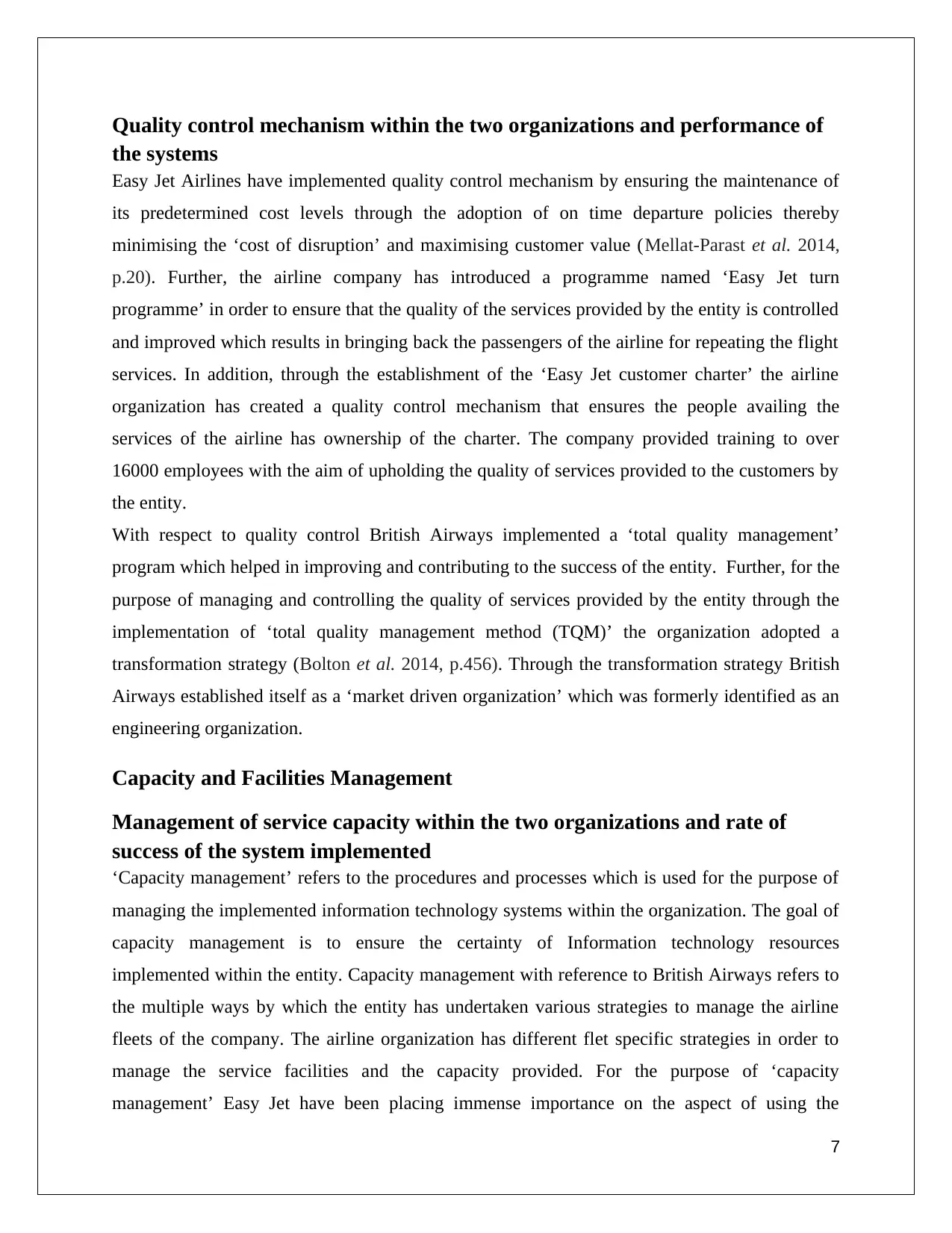
Quality control mechanism within the two organizations and performance of
the systems
Easy Jet Airlines have implemented quality control mechanism by ensuring the maintenance of
its predetermined cost levels through the adoption of on time departure policies thereby
minimising the ‘cost of disruption’ and maximising customer value (Mellat-Parast et al. 2014,
p.20). Further, the airline company has introduced a programme named ‘Easy Jet turn
programme’ in order to ensure that the quality of the services provided by the entity is controlled
and improved which results in bringing back the passengers of the airline for repeating the flight
services. In addition, through the establishment of the ‘Easy Jet customer charter’ the airline
organization has created a quality control mechanism that ensures the people availing the
services of the airline has ownership of the charter. The company provided training to over
16000 employees with the aim of upholding the quality of services provided to the customers by
the entity.
With respect to quality control British Airways implemented a ‘total quality management’
program which helped in improving and contributing to the success of the entity. Further, for the
purpose of managing and controlling the quality of services provided by the entity through the
implementation of ‘total quality management method (TQM)’ the organization adopted a
transformation strategy (Bolton et al. 2014, p.456). Through the transformation strategy British
Airways established itself as a ‘market driven organization’ which was formerly identified as an
engineering organization.
Capacity and Facilities Management
Management of service capacity within the two organizations and rate of
success of the system implemented
‘Capacity management’ refers to the procedures and processes which is used for the purpose of
managing the implemented information technology systems within the organization. The goal of
capacity management is to ensure the certainty of Information technology resources
implemented within the entity. Capacity management with reference to British Airways refers to
the multiple ways by which the entity has undertaken various strategies to manage the airline
fleets of the company. The airline organization has different flet specific strategies in order to
manage the service facilities and the capacity provided. For the purpose of ‘capacity
management’ Easy Jet have been placing immense importance on the aspect of using the
7
the systems
Easy Jet Airlines have implemented quality control mechanism by ensuring the maintenance of
its predetermined cost levels through the adoption of on time departure policies thereby
minimising the ‘cost of disruption’ and maximising customer value (Mellat-Parast et al. 2014,
p.20). Further, the airline company has introduced a programme named ‘Easy Jet turn
programme’ in order to ensure that the quality of the services provided by the entity is controlled
and improved which results in bringing back the passengers of the airline for repeating the flight
services. In addition, through the establishment of the ‘Easy Jet customer charter’ the airline
organization has created a quality control mechanism that ensures the people availing the
services of the airline has ownership of the charter. The company provided training to over
16000 employees with the aim of upholding the quality of services provided to the customers by
the entity.
With respect to quality control British Airways implemented a ‘total quality management’
program which helped in improving and contributing to the success of the entity. Further, for the
purpose of managing and controlling the quality of services provided by the entity through the
implementation of ‘total quality management method (TQM)’ the organization adopted a
transformation strategy (Bolton et al. 2014, p.456). Through the transformation strategy British
Airways established itself as a ‘market driven organization’ which was formerly identified as an
engineering organization.
Capacity and Facilities Management
Management of service capacity within the two organizations and rate of
success of the system implemented
‘Capacity management’ refers to the procedures and processes which is used for the purpose of
managing the implemented information technology systems within the organization. The goal of
capacity management is to ensure the certainty of Information technology resources
implemented within the entity. Capacity management with reference to British Airways refers to
the multiple ways by which the entity has undertaken various strategies to manage the airline
fleets of the company. The airline organization has different flet specific strategies in order to
manage the service facilities and the capacity provided. For the purpose of ‘capacity
management’ Easy Jet have been placing immense importance on the aspect of using the
7
Paraphrase This Document
Need a fresh take? Get an instant paraphrase of this document with our AI Paraphraser
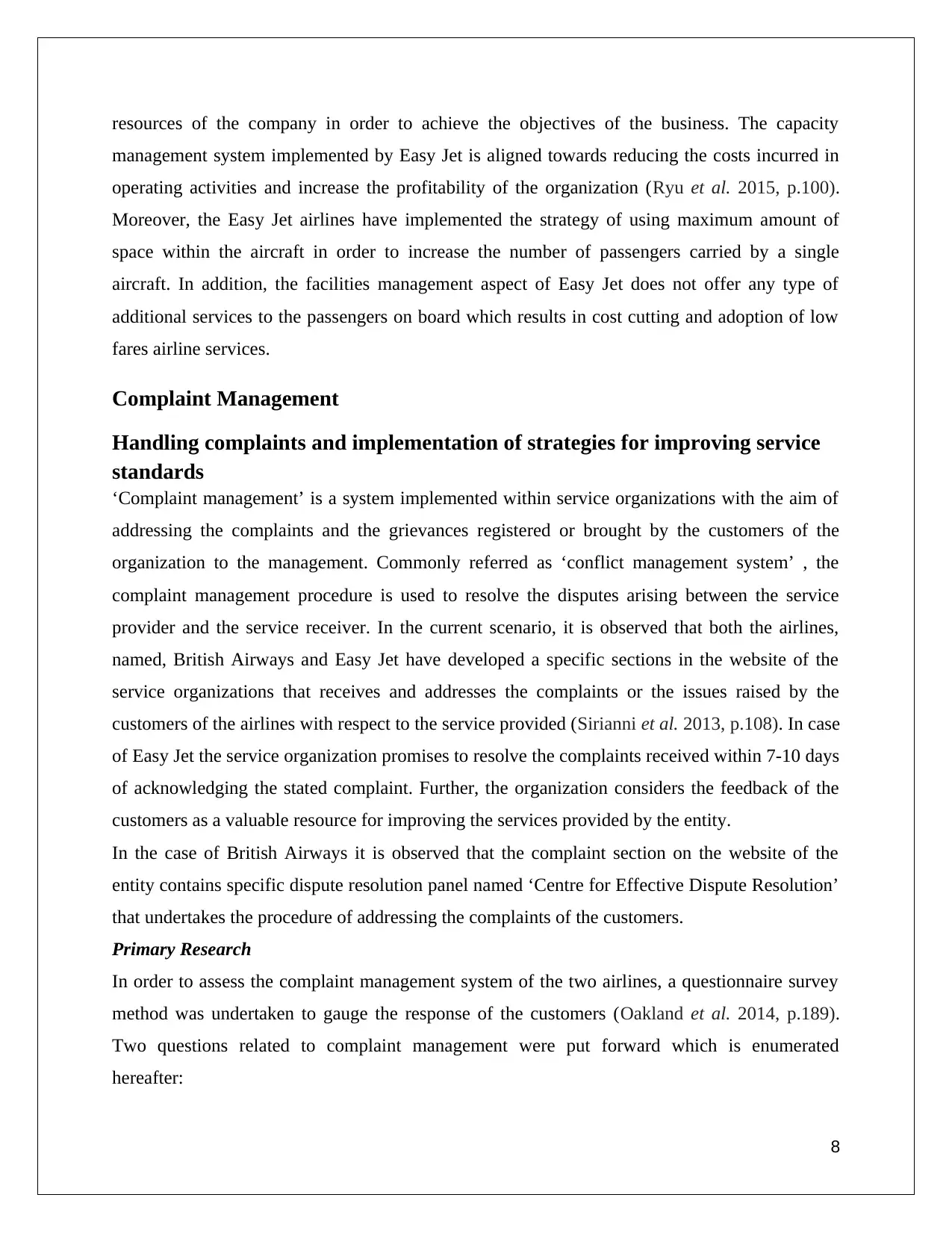
resources of the company in order to achieve the objectives of the business. The capacity
management system implemented by Easy Jet is aligned towards reducing the costs incurred in
operating activities and increase the profitability of the organization (Ryu et al. 2015, p.100).
Moreover, the Easy Jet airlines have implemented the strategy of using maximum amount of
space within the aircraft in order to increase the number of passengers carried by a single
aircraft. In addition, the facilities management aspect of Easy Jet does not offer any type of
additional services to the passengers on board which results in cost cutting and adoption of low
fares airline services.
Complaint Management
Handling complaints and implementation of strategies for improving service
standards
‘Complaint management’ is a system implemented within service organizations with the aim of
addressing the complaints and the grievances registered or brought by the customers of the
organization to the management. Commonly referred as ‘conflict management system’ , the
complaint management procedure is used to resolve the disputes arising between the service
provider and the service receiver. In the current scenario, it is observed that both the airlines,
named, British Airways and Easy Jet have developed a specific sections in the website of the
service organizations that receives and addresses the complaints or the issues raised by the
customers of the airlines with respect to the service provided (Sirianni et al. 2013, p.108). In case
of Easy Jet the service organization promises to resolve the complaints received within 7-10 days
of acknowledging the stated complaint. Further, the organization considers the feedback of the
customers as a valuable resource for improving the services provided by the entity.
In the case of British Airways it is observed that the complaint section on the website of the
entity contains specific dispute resolution panel named ‘Centre for Effective Dispute Resolution’
that undertakes the procedure of addressing the complaints of the customers.
Primary Research
In order to assess the complaint management system of the two airlines, a questionnaire survey
method was undertaken to gauge the response of the customers (Oakland et al. 2014, p.189).
Two questions related to complaint management were put forward which is enumerated
hereafter:
8
management system implemented by Easy Jet is aligned towards reducing the costs incurred in
operating activities and increase the profitability of the organization (Ryu et al. 2015, p.100).
Moreover, the Easy Jet airlines have implemented the strategy of using maximum amount of
space within the aircraft in order to increase the number of passengers carried by a single
aircraft. In addition, the facilities management aspect of Easy Jet does not offer any type of
additional services to the passengers on board which results in cost cutting and adoption of low
fares airline services.
Complaint Management
Handling complaints and implementation of strategies for improving service
standards
‘Complaint management’ is a system implemented within service organizations with the aim of
addressing the complaints and the grievances registered or brought by the customers of the
organization to the management. Commonly referred as ‘conflict management system’ , the
complaint management procedure is used to resolve the disputes arising between the service
provider and the service receiver. In the current scenario, it is observed that both the airlines,
named, British Airways and Easy Jet have developed a specific sections in the website of the
service organizations that receives and addresses the complaints or the issues raised by the
customers of the airlines with respect to the service provided (Sirianni et al. 2013, p.108). In case
of Easy Jet the service organization promises to resolve the complaints received within 7-10 days
of acknowledging the stated complaint. Further, the organization considers the feedback of the
customers as a valuable resource for improving the services provided by the entity.
In the case of British Airways it is observed that the complaint section on the website of the
entity contains specific dispute resolution panel named ‘Centre for Effective Dispute Resolution’
that undertakes the procedure of addressing the complaints of the customers.
Primary Research
In order to assess the complaint management system of the two airlines, a questionnaire survey
method was undertaken to gauge the response of the customers (Oakland et al. 2014, p.189).
Two questions related to complaint management were put forward which is enumerated
hereafter:
8
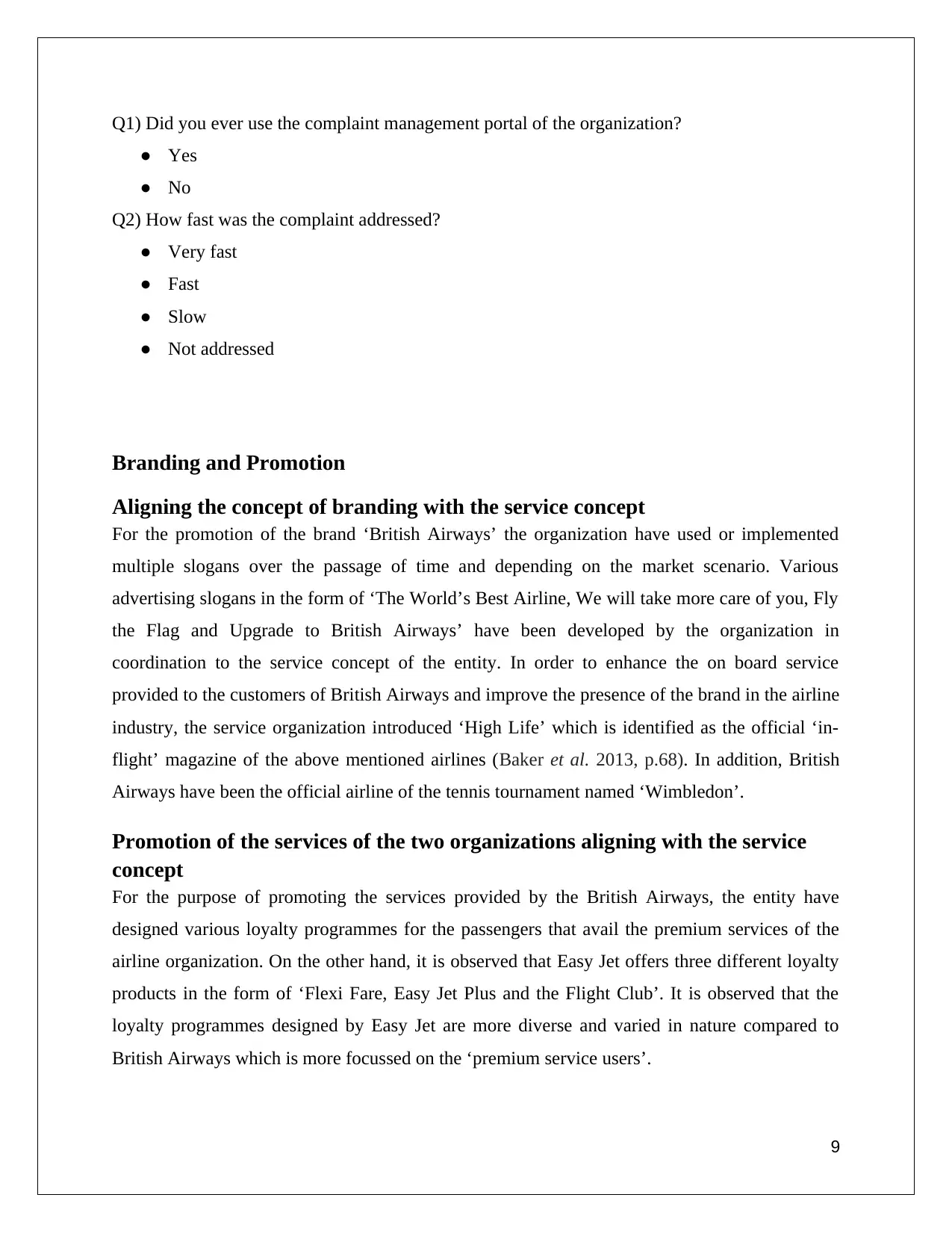
Q1) Did you ever use the complaint management portal of the organization?
● Yes
● No
Q2) How fast was the complaint addressed?
● Very fast
● Fast
● Slow
● Not addressed
Branding and Promotion
Aligning the concept of branding with the service concept
For the promotion of the brand ‘British Airways’ the organization have used or implemented
multiple slogans over the passage of time and depending on the market scenario. Various
advertising slogans in the form of ‘The World’s Best Airline, We will take more care of you, Fly
the Flag and Upgrade to British Airways’ have been developed by the organization in
coordination to the service concept of the entity. In order to enhance the on board service
provided to the customers of British Airways and improve the presence of the brand in the airline
industry, the service organization introduced ‘High Life’ which is identified as the official ‘in-
flight’ magazine of the above mentioned airlines (Baker et al. 2013, p.68). In addition, British
Airways have been the official airline of the tennis tournament named ‘Wimbledon’.
Promotion of the services of the two organizations aligning with the service
concept
For the purpose of promoting the services provided by the British Airways, the entity have
designed various loyalty programmes for the passengers that avail the premium services of the
airline organization. On the other hand, it is observed that Easy Jet offers three different loyalty
products in the form of ‘Flexi Fare, Easy Jet Plus and the Flight Club’. It is observed that the
loyalty programmes designed by Easy Jet are more diverse and varied in nature compared to
British Airways which is more focussed on the ‘premium service users’.
9
● Yes
● No
Q2) How fast was the complaint addressed?
● Very fast
● Fast
● Slow
● Not addressed
Branding and Promotion
Aligning the concept of branding with the service concept
For the promotion of the brand ‘British Airways’ the organization have used or implemented
multiple slogans over the passage of time and depending on the market scenario. Various
advertising slogans in the form of ‘The World’s Best Airline, We will take more care of you, Fly
the Flag and Upgrade to British Airways’ have been developed by the organization in
coordination to the service concept of the entity. In order to enhance the on board service
provided to the customers of British Airways and improve the presence of the brand in the airline
industry, the service organization introduced ‘High Life’ which is identified as the official ‘in-
flight’ magazine of the above mentioned airlines (Baker et al. 2013, p.68). In addition, British
Airways have been the official airline of the tennis tournament named ‘Wimbledon’.
Promotion of the services of the two organizations aligning with the service
concept
For the purpose of promoting the services provided by the British Airways, the entity have
designed various loyalty programmes for the passengers that avail the premium services of the
airline organization. On the other hand, it is observed that Easy Jet offers three different loyalty
products in the form of ‘Flexi Fare, Easy Jet Plus and the Flight Club’. It is observed that the
loyalty programmes designed by Easy Jet are more diverse and varied in nature compared to
British Airways which is more focussed on the ‘premium service users’.
9
⊘ This is a preview!⊘
Do you want full access?
Subscribe today to unlock all pages.

Trusted by 1+ million students worldwide
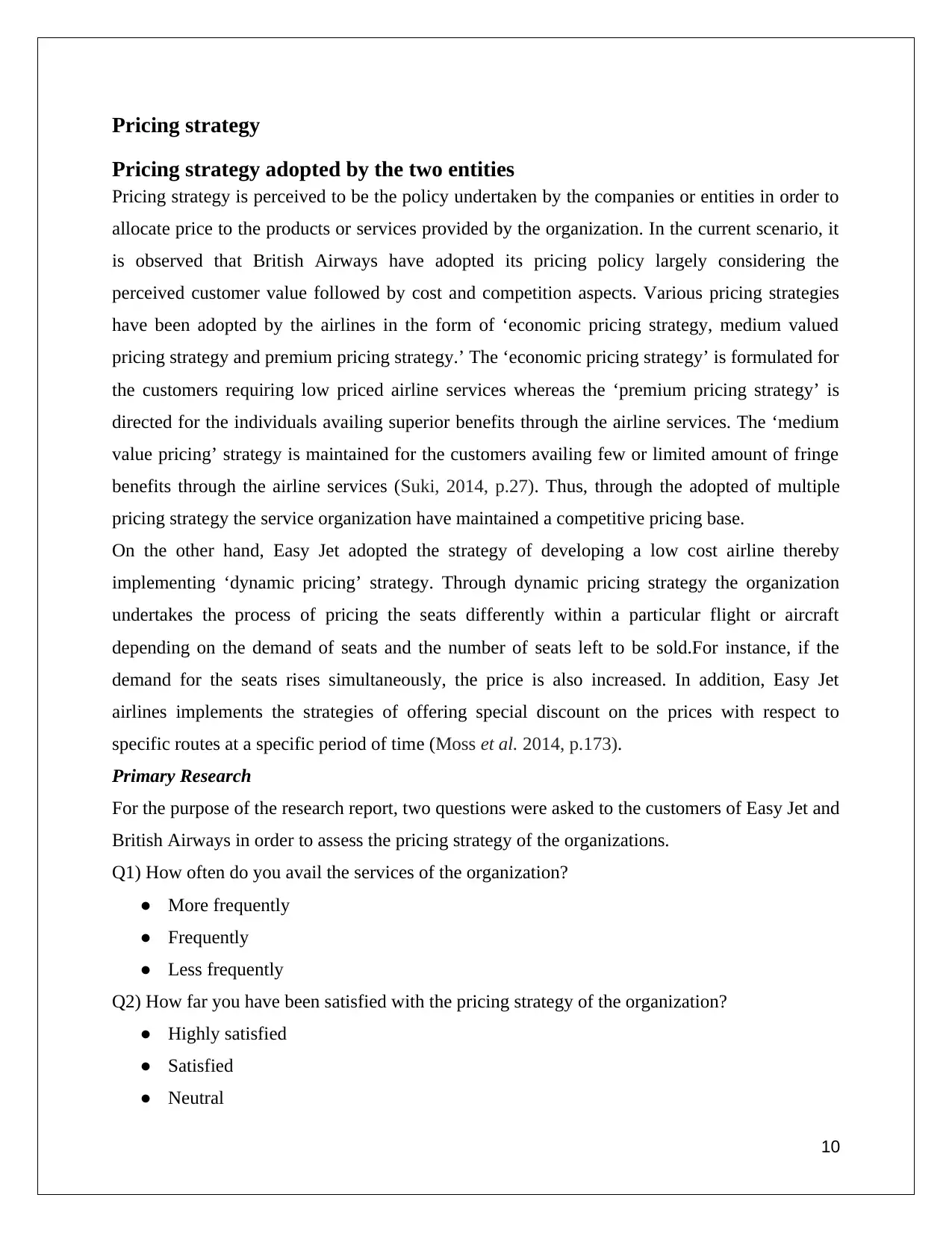
Pricing strategy
Pricing strategy adopted by the two entities
Pricing strategy is perceived to be the policy undertaken by the companies or entities in order to
allocate price to the products or services provided by the organization. In the current scenario, it
is observed that British Airways have adopted its pricing policy largely considering the
perceived customer value followed by cost and competition aspects. Various pricing strategies
have been adopted by the airlines in the form of ‘economic pricing strategy, medium valued
pricing strategy and premium pricing strategy.’ The ‘economic pricing strategy’ is formulated for
the customers requiring low priced airline services whereas the ‘premium pricing strategy’ is
directed for the individuals availing superior benefits through the airline services. The ‘medium
value pricing’ strategy is maintained for the customers availing few or limited amount of fringe
benefits through the airline services (Suki, 2014, p.27). Thus, through the adopted of multiple
pricing strategy the service organization have maintained a competitive pricing base.
On the other hand, Easy Jet adopted the strategy of developing a low cost airline thereby
implementing ‘dynamic pricing’ strategy. Through dynamic pricing strategy the organization
undertakes the process of pricing the seats differently within a particular flight or aircraft
depending on the demand of seats and the number of seats left to be sold.For instance, if the
demand for the seats rises simultaneously, the price is also increased. In addition, Easy Jet
airlines implements the strategies of offering special discount on the prices with respect to
specific routes at a specific period of time (Moss et al. 2014, p.173).
Primary Research
For the purpose of the research report, two questions were asked to the customers of Easy Jet and
British Airways in order to assess the pricing strategy of the organizations.
Q1) How often do you avail the services of the organization?
● More frequently
● Frequently
● Less frequently
Q2) How far you have been satisfied with the pricing strategy of the organization?
● Highly satisfied
● Satisfied
● Neutral
10
Pricing strategy adopted by the two entities
Pricing strategy is perceived to be the policy undertaken by the companies or entities in order to
allocate price to the products or services provided by the organization. In the current scenario, it
is observed that British Airways have adopted its pricing policy largely considering the
perceived customer value followed by cost and competition aspects. Various pricing strategies
have been adopted by the airlines in the form of ‘economic pricing strategy, medium valued
pricing strategy and premium pricing strategy.’ The ‘economic pricing strategy’ is formulated for
the customers requiring low priced airline services whereas the ‘premium pricing strategy’ is
directed for the individuals availing superior benefits through the airline services. The ‘medium
value pricing’ strategy is maintained for the customers availing few or limited amount of fringe
benefits through the airline services (Suki, 2014, p.27). Thus, through the adopted of multiple
pricing strategy the service organization have maintained a competitive pricing base.
On the other hand, Easy Jet adopted the strategy of developing a low cost airline thereby
implementing ‘dynamic pricing’ strategy. Through dynamic pricing strategy the organization
undertakes the process of pricing the seats differently within a particular flight or aircraft
depending on the demand of seats and the number of seats left to be sold.For instance, if the
demand for the seats rises simultaneously, the price is also increased. In addition, Easy Jet
airlines implements the strategies of offering special discount on the prices with respect to
specific routes at a specific period of time (Moss et al. 2014, p.173).
Primary Research
For the purpose of the research report, two questions were asked to the customers of Easy Jet and
British Airways in order to assess the pricing strategy of the organizations.
Q1) How often do you avail the services of the organization?
● More frequently
● Frequently
● Less frequently
Q2) How far you have been satisfied with the pricing strategy of the organization?
● Highly satisfied
● Satisfied
● Neutral
10
Paraphrase This Document
Need a fresh take? Get an instant paraphrase of this document with our AI Paraphraser
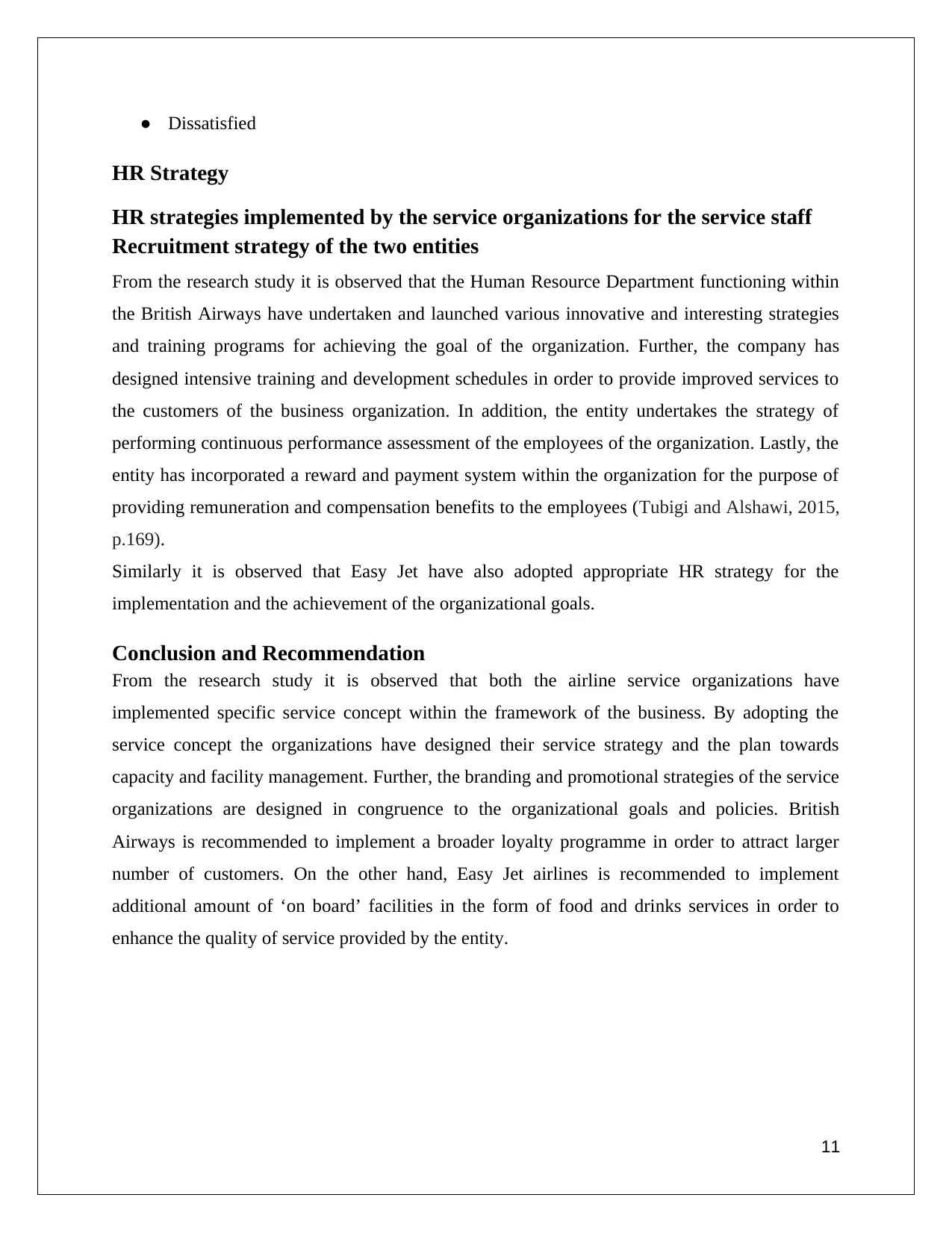
● Dissatisfied
HR Strategy
HR strategies implemented by the service organizations for the service staff
Recruitment strategy of the two entities
From the research study it is observed that the Human Resource Department functioning within
the British Airways have undertaken and launched various innovative and interesting strategies
and training programs for achieving the goal of the organization. Further, the company has
designed intensive training and development schedules in order to provide improved services to
the customers of the business organization. In addition, the entity undertakes the strategy of
performing continuous performance assessment of the employees of the organization. Lastly, the
entity has incorporated a reward and payment system within the organization for the purpose of
providing remuneration and compensation benefits to the employees (Tubigi and Alshawi, 2015,
p.169).
Similarly it is observed that Easy Jet have also adopted appropriate HR strategy for the
implementation and the achievement of the organizational goals.
Conclusion and Recommendation
From the research study it is observed that both the airline service organizations have
implemented specific service concept within the framework of the business. By adopting the
service concept the organizations have designed their service strategy and the plan towards
capacity and facility management. Further, the branding and promotional strategies of the service
organizations are designed in congruence to the organizational goals and policies. British
Airways is recommended to implement a broader loyalty programme in order to attract larger
number of customers. On the other hand, Easy Jet airlines is recommended to implement
additional amount of ‘on board’ facilities in the form of food and drinks services in order to
enhance the quality of service provided by the entity.
11
HR Strategy
HR strategies implemented by the service organizations for the service staff
Recruitment strategy of the two entities
From the research study it is observed that the Human Resource Department functioning within
the British Airways have undertaken and launched various innovative and interesting strategies
and training programs for achieving the goal of the organization. Further, the company has
designed intensive training and development schedules in order to provide improved services to
the customers of the business organization. In addition, the entity undertakes the strategy of
performing continuous performance assessment of the employees of the organization. Lastly, the
entity has incorporated a reward and payment system within the organization for the purpose of
providing remuneration and compensation benefits to the employees (Tubigi and Alshawi, 2015,
p.169).
Similarly it is observed that Easy Jet have also adopted appropriate HR strategy for the
implementation and the achievement of the organizational goals.
Conclusion and Recommendation
From the research study it is observed that both the airline service organizations have
implemented specific service concept within the framework of the business. By adopting the
service concept the organizations have designed their service strategy and the plan towards
capacity and facility management. Further, the branding and promotional strategies of the service
organizations are designed in congruence to the organizational goals and policies. British
Airways is recommended to implement a broader loyalty programme in order to attract larger
number of customers. On the other hand, Easy Jet airlines is recommended to implement
additional amount of ‘on board’ facilities in the form of food and drinks services in order to
enhance the quality of service provided by the entity.
11
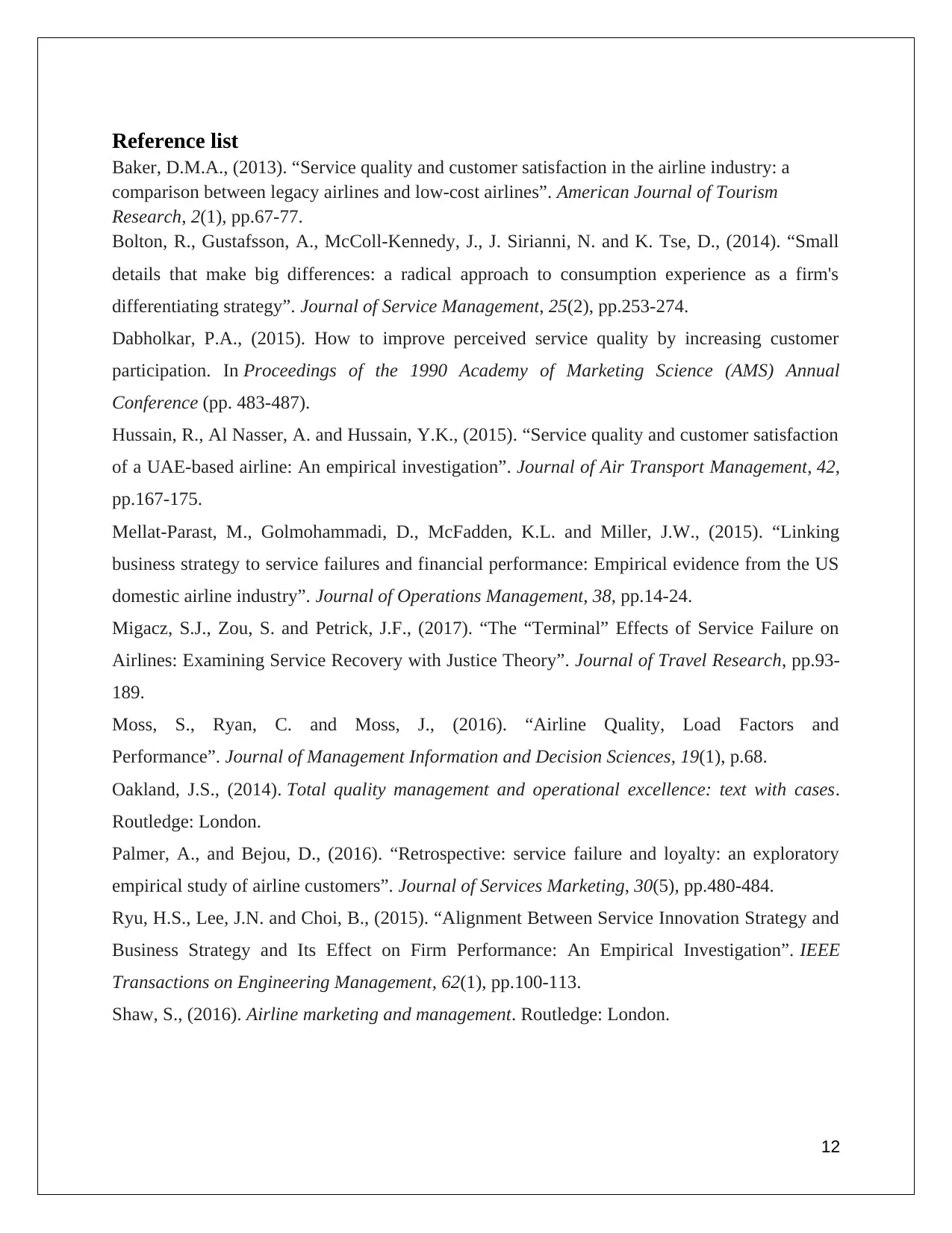
Reference list
Baker, D.M.A., (2013). “Service quality and customer satisfaction in the airline industry: a
comparison between legacy airlines and low-cost airlines”. American Journal of Tourism
Research, 2(1), pp.67-77.
Bolton, R., Gustafsson, A., McColl-Kennedy, J., J. Sirianni, N. and K. Tse, D., (2014). “Small
details that make big differences: a radical approach to consumption experience as a firm's
differentiating strategy”. Journal of Service Management, 25(2), pp.253-274.
Dabholkar, P.A., (2015). How to improve perceived service quality by increasing customer
participation. In Proceedings of the 1990 Academy of Marketing Science (AMS) Annual
Conference (pp. 483-487).
Hussain, R., Al Nasser, A. and Hussain, Y.K., (2015). “Service quality and customer satisfaction
of a UAE-based airline: An empirical investigation”. Journal of Air Transport Management, 42,
pp.167-175.
Mellat-Parast, M., Golmohammadi, D., McFadden, K.L. and Miller, J.W., (2015). “Linking
business strategy to service failures and financial performance: Empirical evidence from the US
domestic airline industry”. Journal of Operations Management, 38, pp.14-24.
Migacz, S.J., Zou, S. and Petrick, J.F., (2017). “The “Terminal” Effects of Service Failure on
Airlines: Examining Service Recovery with Justice Theory”. Journal of Travel Research, pp.93-
189.
Moss, S., Ryan, C. and Moss, J., (2016). “Airline Quality, Load Factors and
Performance”. Journal of Management Information and Decision Sciences, 19(1), p.68.
Oakland, J.S., (2014). Total quality management and operational excellence: text with cases.
Routledge: London.
Palmer, A., and Bejou, D., (2016). “Retrospective: service failure and loyalty: an exploratory
empirical study of airline customers”. Journal of Services Marketing, 30(5), pp.480-484.
Ryu, H.S., Lee, J.N. and Choi, B., (2015). “Alignment Between Service Innovation Strategy and
Business Strategy and Its Effect on Firm Performance: An Empirical Investigation”. IEEE
Transactions on Engineering Management, 62(1), pp.100-113.
Shaw, S., (2016). Airline marketing and management. Routledge: London.
12
Baker, D.M.A., (2013). “Service quality and customer satisfaction in the airline industry: a
comparison between legacy airlines and low-cost airlines”. American Journal of Tourism
Research, 2(1), pp.67-77.
Bolton, R., Gustafsson, A., McColl-Kennedy, J., J. Sirianni, N. and K. Tse, D., (2014). “Small
details that make big differences: a radical approach to consumption experience as a firm's
differentiating strategy”. Journal of Service Management, 25(2), pp.253-274.
Dabholkar, P.A., (2015). How to improve perceived service quality by increasing customer
participation. In Proceedings of the 1990 Academy of Marketing Science (AMS) Annual
Conference (pp. 483-487).
Hussain, R., Al Nasser, A. and Hussain, Y.K., (2015). “Service quality and customer satisfaction
of a UAE-based airline: An empirical investigation”. Journal of Air Transport Management, 42,
pp.167-175.
Mellat-Parast, M., Golmohammadi, D., McFadden, K.L. and Miller, J.W., (2015). “Linking
business strategy to service failures and financial performance: Empirical evidence from the US
domestic airline industry”. Journal of Operations Management, 38, pp.14-24.
Migacz, S.J., Zou, S. and Petrick, J.F., (2017). “The “Terminal” Effects of Service Failure on
Airlines: Examining Service Recovery with Justice Theory”. Journal of Travel Research, pp.93-
189.
Moss, S., Ryan, C. and Moss, J., (2016). “Airline Quality, Load Factors and
Performance”. Journal of Management Information and Decision Sciences, 19(1), p.68.
Oakland, J.S., (2014). Total quality management and operational excellence: text with cases.
Routledge: London.
Palmer, A., and Bejou, D., (2016). “Retrospective: service failure and loyalty: an exploratory
empirical study of airline customers”. Journal of Services Marketing, 30(5), pp.480-484.
Ryu, H.S., Lee, J.N. and Choi, B., (2015). “Alignment Between Service Innovation Strategy and
Business Strategy and Its Effect on Firm Performance: An Empirical Investigation”. IEEE
Transactions on Engineering Management, 62(1), pp.100-113.
Shaw, S., (2016). Airline marketing and management. Routledge: London.
12
⊘ This is a preview!⊘
Do you want full access?
Subscribe today to unlock all pages.

Trusted by 1+ million students worldwide
1 out of 13
Related Documents
Your All-in-One AI-Powered Toolkit for Academic Success.
+13062052269
info@desklib.com
Available 24*7 on WhatsApp / Email
![[object Object]](/_next/static/media/star-bottom.7253800d.svg)
Unlock your academic potential
Copyright © 2020–2025 A2Z Services. All Rights Reserved. Developed and managed by ZUCOL.





